Induction Heating Characteristics of Electroless Ni-Coated CFRP for Deicing and Anti-Icing
Abstract
:1. Introduction
2. Materials and Methods
2.1. Experimental Materials
2.2. Pretreatment of CFRP Substrate
2.3. Electroless Nickel Coating on CFRP
2.4. Characterization
3. Results and Discussion
3.1. Mechanism of Electroless Nickel Plating on CFRP
3.2. Crystal Structure
3.3. Surface Morphology and Hydrophobic Property
3.4. Adhesion
3.5. Electrical Conductivity
3.6. Heating Performance
3.6.1. The Influence of Deposit Weight on Heating Efficiency
3.6.2. The Influence of Input Voltage on Induction Heating Efficiency
3.6.3. Repeatability
3.6.4. Effect of Ice Thickness on Melting Rate
4. Conclusions
Author Contributions
Funding
Institutional Review Board Statement
Informed Consent Statement
Data Availability Statement
Conflicts of Interest
References
- Greene, J. Guidebook for Selecting Methods to Monitor Airport and Aircraft Deicing Materials, 2nd ed.; Transportation Research Board of the National Academies: Washington, DC, USA, 2017. [Google Scholar]
- Tundis, A.; Ferretto, D.; Garro, A.; Brusa, E.; Muhlhauser, M. Dependability assessment of a deicing system through the RAMSAS method. In Proceedings of the 2017 IEEE International Symposium on Systems Engineering (Isse 2017), Vienna, Austria, 11–13 October 2017; pp. 106–113. [Google Scholar]
- Glover, E.N.K.; Bowen, C.R.; Gathercole, N.; Pountney, O.; Ball, M.; Spacie, C.; Seunarine, K. Graphene based skins on thermally responsive composites for deicing applications. Proc. SPIE 2017, 10165, 106–119. [Google Scholar] [CrossRef]
- De Pauw, D.; Dolatabadi, A. Effect of Superhydrophobic Coating on the Anti-Icing and Deicing of an Airfoil. J. Aircr. 2017, 54, 490–499. [Google Scholar] [CrossRef]
- Porter, D.J. Flight Failure: Investigating the Nuts and Bolts of Air Disasters and Aviation Safety; Rowman & Littlefield Publishing Group, Inc.: Lanham, MD, USA, 2020. [Google Scholar]
- Shen, X.; Wang, H.; Lin, G.; Bu, X.; Wen, D. Unsteady simulation of aircraft electro-thermal deicing process with temperature-based method. Proc. Inst. Mech. Eng. Part G J. Aerosp. Eng. 2019, 234, 388–400. [Google Scholar] [CrossRef]
- Sabatier, J.; Lanusse, P.; Feytout, B.; Gracia, S. Ice Accretion Detection and Anti-icing/Deicing Systems for Wind Turbine Blades; Lecture Notes in Electrical Engineering; Springer: Cham, Switzerland, 2020; Volume 495, pp. 641–663. [Google Scholar] [CrossRef]
- Xu, B.; Lu, F.; Song, G. Experimental Study on Anti-Icing and Deicing for Model Wind Turbine Blades with Continuous Carbon Fiber Sheets. J. Cold Reg. Eng. 2018, 32, 1. [Google Scholar] [CrossRef]
- Chavan, D.S.; Singh, A.; Sankpal, J.; Himanshu; Gaikwad, S.; Saahil, V.; Parashar, D.; Karandikar, P.B. Deicing of wind turbine blade by high frequency dielectric heating fabricating blade as a capacitor. In Proceedings of the 2017 IEEE International Conference on Circuit, Power and Computing Technologies (Iccpct), Kollam, India, 20–21 April 2017. [Google Scholar]
- Zhang, Z.; Shen, X.; Lin, G.; Yuan, Q.; Tian, S. Dynamic response analysis of multi-excitation structure of electro-impulse deicing system. In Proceedings of the 2016 Ieee/Csaa International Conference on Aircraft Utility Systems (Aus), Beijing, China, 10–12 October 2016; pp. 955–960. [Google Scholar] [CrossRef]
- Wu, T.; Sun, M.; Huang, B. Strain modulation of phase transformation of noble metal nanomaterials. Infomat 2020, 2, 715–734. [Google Scholar] [CrossRef]
- Shi, Y.; Jia, Y. Multimodal Shear Wave Deicing Using Fibre Piezoelectric Actuator on Composite for Aircraft Wings. IEEE/ASME Trans. Mechatron. 2018, 23, 2090–2098. [Google Scholar] [CrossRef]
- Ma, L.W.; Wang, J.K.; Zhao, F.T.; Wu, D.Q.; Huan, Y.; Zhang, D.W.; Zhang, Z.J.; Fu, W.Y.; Li, X.G.; Fan, Y. Plasmon-mediated photothermal and superhydrophobic TiN-PTFE film for anti-icing/deicing applications. Compos. Sci. Technol. 2019, 181, 107696. [Google Scholar]
- Gavrichkova, O.; Hajiaghayeva, R.A.; Liberati, D.; Pallozzi, E.; Calfapietra, C.; Vasenev, V. Effects of the Road Deicing Practices on Gas Exchange Parameters in Urban Lawn Ecosystems; Spring: Berlin/Heidelberg, Germany, 2020; pp. 45–51. [Google Scholar] [CrossRef]
- Dan, H.-C.; Tan, J.-W.; Du, Y.-F.; Cai, J.-M. Simulation and optimization of road deicing salt usage based on Water-Ice-Salt Model. Cold Reg. Sci. Technol. 2020, 169, 102917. [Google Scholar] [CrossRef]
- Yuan, J.; Du, Z.; Wu, Y.; Xiao, F. Freezing-thawing resistance evaluations of concrete pavements with deicing salts based on various surfaces and air void parameters. Constr. Build. Mater. 2019, 204, 317–326. [Google Scholar] [CrossRef]
- Xie, T.; Dong, J.; Chen, H.; Jiang, Y.; Yao, Y. Experimental investigation of deicing characteristics using hot air as heat source. Appl. Therm. Eng. 2016, 107, 681–688. [Google Scholar] [CrossRef]
- Jiang, G.; Chen, L.; Zhang, S.; Huang, H.-X. Superhydrophobic SiC/CNTs Coatings with Photothermal Deicing and Passive Anti-Icing Properties. ACS Appl. Mater. Interfaces 2018, 10, 36505–36511. [Google Scholar] [CrossRef] [PubMed]
- Liu, Z.Y.; Mu, Z.; Wang, J.K.; Chang, Z.; Liu, J. Design and Parameter Analysis of Laser Deicing Optical System. Acta Photonica Sin. 2018, 47, 0822001. [Google Scholar]
- Eden, P.E. The World’s Most Powerful Civilian Aircraft; Rosen Publishing: New York, NY, USA, 2017. [Google Scholar]
- United States Congress House. Committee on Transportation and Infrastructure. Subcommittee on Aviation, Lessons Learned from the Boeing 787 Incidents: Hearing before the Subcommittee on Aviation of the Committee on Transportation and Infrastructure, House of Representatives, one Hundred Thirteenth Congress, First Session, June 12, 2013; U.S. Government Printing Office for Sale by the Superintendent of Documents: Washington, DC, USA, 2013.
- Liu, T.; Li, Y. Addressing the Achilles’ heel of pseudocapacitive materials: Long-term stability. InfoMat 2020, 2, 807–842. [Google Scholar] [CrossRef]
- Ke, G.; Duan, C.; Huang, F.; Guo, X. Electrical and spin switches in single-molecule junctions. InfoMat 2019, 2, 92–112. [Google Scholar] [CrossRef]
- Thiel, C.; Gehlen, C.; Foestl, F. Service life prediction of concrete under freeze-thaw deicing salt attack with intermittent dry periods. In Life-Cycle Analysis and Assessment in Civil Engineering: Towards an Integrated Vision; CRC Press: Boca Raton, FL, USA, 2019; pp. 521–528. [Google Scholar]
- Wu, J.; Li, H.; Lai, X.; Chen, Z.; Zeng, X. Superhydrophobic Polydimethylsiloxane@Multiwalled Carbon Nanotubes Membrane for Effective Water-in-Oil Emulsions Separation and Quick Deicing. Ind. Eng. Chem. Res. 2019, 58, 8791–8799. [Google Scholar] [CrossRef]
- Tarfaoui, M.; El Moumen, A.; Boehle, M.; Shah, O.; Lafdi, K. Self-heating and deicing epoxy/glass fiber based carbon nanotubes buckypaper composite. J. Mater. Sci. 2019, 54, 1351–1362. [Google Scholar] [CrossRef]
- Chu, Z.M.; Jiao, W.C.; Huang, Y.F.; Ding, G.M.; Zhong, X.; Yan, M.L.; Zheng, Y.T.; Wang, R.G. FDTS-Modified SiO2/rGO Wrinkled Films with a Micro-Nanoscale Hierarchical Structure and Anti-Icing/Deicing Properties under Condensation Condition. Adv. Mater. Interfaces 2019, 7, 1901446. [Google Scholar] [CrossRef]
- Redondo, O.; Prolongo, S.G.; Campo, M.; Sbarufatti, C.; Giglio, M. Anti-icing and de-icing coatings based Joule’s heating of graphene nanoplatelets. Compos. Sci. Technol. 2018, 164, 65–73. [Google Scholar] [CrossRef]
- Jang, S.-H.; Park, Y.-L. Carbon nanotube-reinforced smart composites for sensing freezing temperature and deicing by self-heating. Nanomater. Nanotechnol. 2018, 8, 1847980418776473. [Google Scholar] [CrossRef]
- Jiang, H.; Wang, H.; Liu, G.; Su, Z.; Wu, J.; Liu, J.; Zhang, X.; Chen, Y.; Zhou, W. Light-weight, flexible, low-voltage electro-thermal film using graphite nanoplatelets for wearable/smart electronics and deicing devices. J. Alloys Compd. 2017, 699, 1049–1056. [Google Scholar] [CrossRef]
- Choi, B.-K.; Park, S.-J.; Seo, M.-K. Effect of Processing Parameters on the Thermal and Electrical Properties of Electroless Nickel-Phosphorus Plated Carbon Fiber Heating Elements. C-J Carbon Res. 2020, 6, 6. [Google Scholar] [CrossRef]
- Jeong, H.; Lee, C.-J.; Myung, W.-R.; Min, K.D.; Jung, S.-B. Effects of Temperature–Humidity Treatment on Bending Reliability of Epoxy Sn–58Bi Solder with Electroless Nickel Immersion Gold (ENIG) and Electroless Nickel Electroless Palladium Immersion Gold (ENEPIG) Surface Finishes. Sci. Adv. Mater. 2020, 12, 564–570. [Google Scholar] [CrossRef]
- Moazzenchi, B.; Montazer, M. Click Electroless Plating and Sonoplating of Polyester with Copper Nanoparticles Producing Conductive Fabric. Fibers Polym. 2020, 21, 522–531. [Google Scholar] [CrossRef]
- Moazzenchi, B.; Montazer, M. Click electroless plating of nickel nanoparticles on polyester fabric: Electrical conductivity, magnetic and EMI shielding properties. Colloids Surf. A 2019, 571, 110–124. [Google Scholar] [CrossRef]
- Peng, L.; Guo, R.; Lan, J.; Jiang, S. Fabrication and Characterization of Photochromic Spirooxazine/Polyvinylidene Fluoride Fiber Membranes via Electrospinning. Fibres Text. East. Eur. 2018, 26, 34–38. [Google Scholar] [CrossRef]
- Guo, R.; Jing, X.; Peng, L.; Lan, J.; Jiang, S.; Yan, W. Nickel-catalyzed deposition of Cu film on PET fabric with supercritical fluid. J. Mater. Sci. Mater. Electron. 2017, 28, 16618–16626. [Google Scholar] [CrossRef]
- Peng, L.; Guo, R.; Lan, J.; Jiang, S.; Zhang, Z.; Xu, J. Preparation and characterization of copper-coated polyester fabric pretreated with laser by magnetron sputtering. J. Ind. Text. 2018, 48, 482–493. [Google Scholar] [CrossRef]
- Shang, W.; Zhan, X.; Wen, Y.; Li, Y.; Zhang, Z.; Wu, F.; Wang, C. Deposition mechanism of electroless nickel plating of composite coatings on magnesium alloy. Chem. Eng. Sci. 2019, 207, 1299–1308. [Google Scholar] [CrossRef]
- Hu, R.; Su, Y.; Liu, H. Deposition behaviour of nickel phosphorus coating on magnesium alloy in a weak corrosive electroless nickel plating bath. J. Alloys Compd. 2016, 658, 555–560. [Google Scholar] [CrossRef]
- Liu, C.; Li, X.; Li, X.; Xu, T.; Song, C.; Ogino, K.; Gu, Z. Preparation of Conductive Polyester Fibers Using Continuous Two-Step Plating Silver. Materials 2018, 11, 2033. [Google Scholar] [CrossRef]
- Kang, J.-S.; Lee, Y.-S.; Lee, J.-H. Effects of Bath Composition and P Contents on the Defects of NiP Layer in Electroless Nickel Immersion Gold Process. J. Nanosci. Nanotechnol. 2019, 19, 4287–4291. [Google Scholar] [CrossRef]
- Rao, L.; Tang, J.; Hu, S.; Shen, L.; Xu, Y.; Li, R.; Lin, H. Inkjet printing assisted electroless Ni plating to fabricate nickel coated polypropylene membrane with improved performance. J. Colloid Interface Sci. 2020, 565, 546–554. [Google Scholar] [CrossRef] [PubMed]
- Gill, T.M.; Zhao, J.; Berenschot, E.J.W.; Tas, N.; Zheng, X. Conformal Electroless Nickel Plating on Silicon Wafers, Convex and Concave Pyramids, and Ultralong Nanowires. ACS Appl. Mater. Interfaces 2018, 10, 22834–22840. [Google Scholar] [CrossRef]
- Hsieh, S.H.; Hsieh, J.M.; Chen, W.J.; Chuang, C.C. Electroless Nickel Deposition for Front Side Metallization of Silicon Solar Cells. Materials 2017, 10, 942. [Google Scholar] [CrossRef] [PubMed]
- Agarwal, A.; Pujari, M.; Uppaluri, R.; Verma, A. Efficacy of reducing agent and surfactant contacting pattern on the performance characteristics of nickel electroless plating baths coupled with and without ultrasound. Ultrason. Sonochem. 2014, 21, 1382–1391. [Google Scholar] [CrossRef] [PubMed]
- Bonin, L.; Bains, N.; Vitry, V.; Cobley, A. Electroless deposition of nickel-boron coatings using low frequency ultrasonic agitation: Effect of ultrasonic frequency on the coatings. Ultrasonics 2017, 77, 61–68. [Google Scholar] [CrossRef]
- Popescu, S.M.; Barlow, A.J.; Ramadan, S.; Ganti, S.; Ghosh, B.; Hedley, J. Electroless Nickel Deposition: An Alternative for Graphene Contacting. ACS Appl. Mater. Interfaces 2016, 8, 31359–31367. [Google Scholar] [CrossRef] [PubMed]
- GB/T 9286-1998; Paints and Varnishes—Cross Cut Test for films. National Quality and Technology Supervision Bureau: Beijing, China, 1998.
- Yoshikawa, R.; Tenjimbayashi, M.; Matsubayashi, T.; Manabe, K.; Magagnin, L.; Monnai, Y.; Shiratori, S. Designing a Flexible and Transparent Ultrarapid Electrothermogenic Film Based on Thermal Loss Suppression Effect: A Self-Fused Cu/Ni Composite Junctionless Nanonetwork for Effective Deicing Heater. ACS Appl. Nano Mater. 2018, 1, 860–868. [Google Scholar] [CrossRef]
- Kim, G.; Lim, J.W.; Yeon, C.; Kim, T.; Lee, H.C.; Yun, S.J. Effective deicing of vehicle windows and thermal response of asymmetric multilayered transparent-film heaters. J. Alloys Compd. 2019, 774, 1092–1101. [Google Scholar] [CrossRef]
- Chen, B.; Gao, D.; Wang, L. Research of Multi-Information Integration for the Aircraft Ground Centralized Deicing Monitoring System Based on Wireless Data Transmission. IEEE Access 2018, 6, 52460–52470. [Google Scholar] [CrossRef]

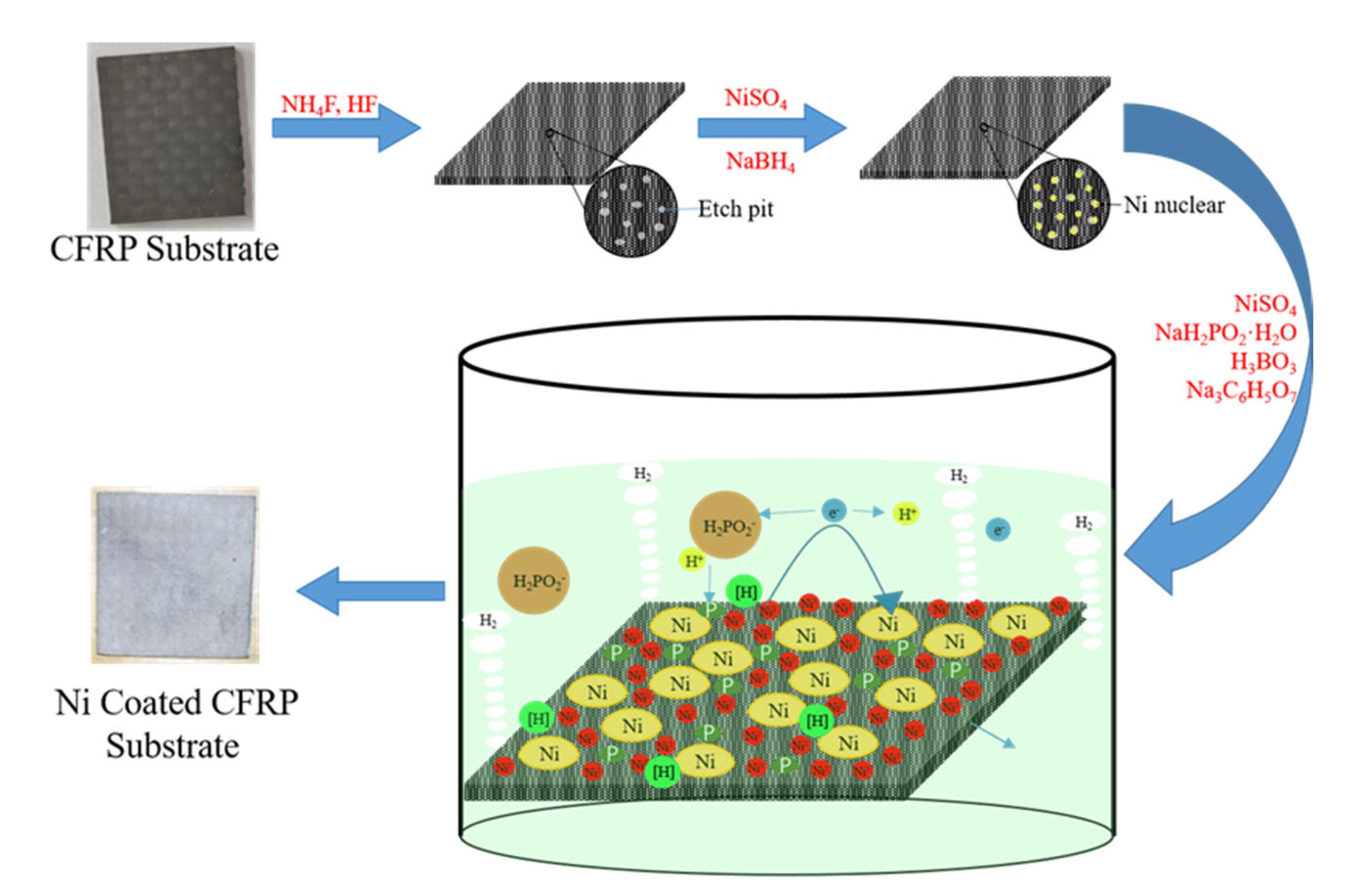
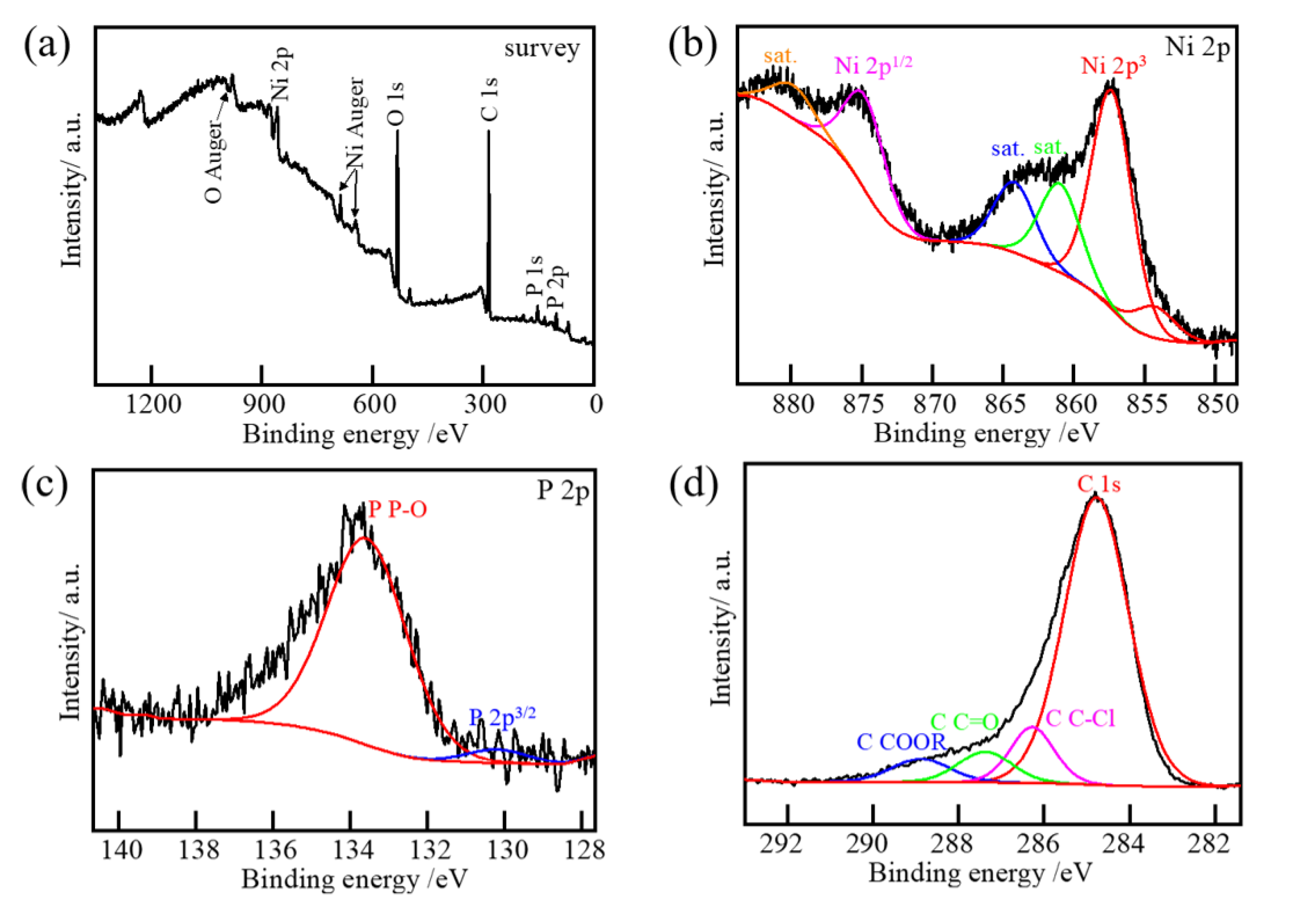

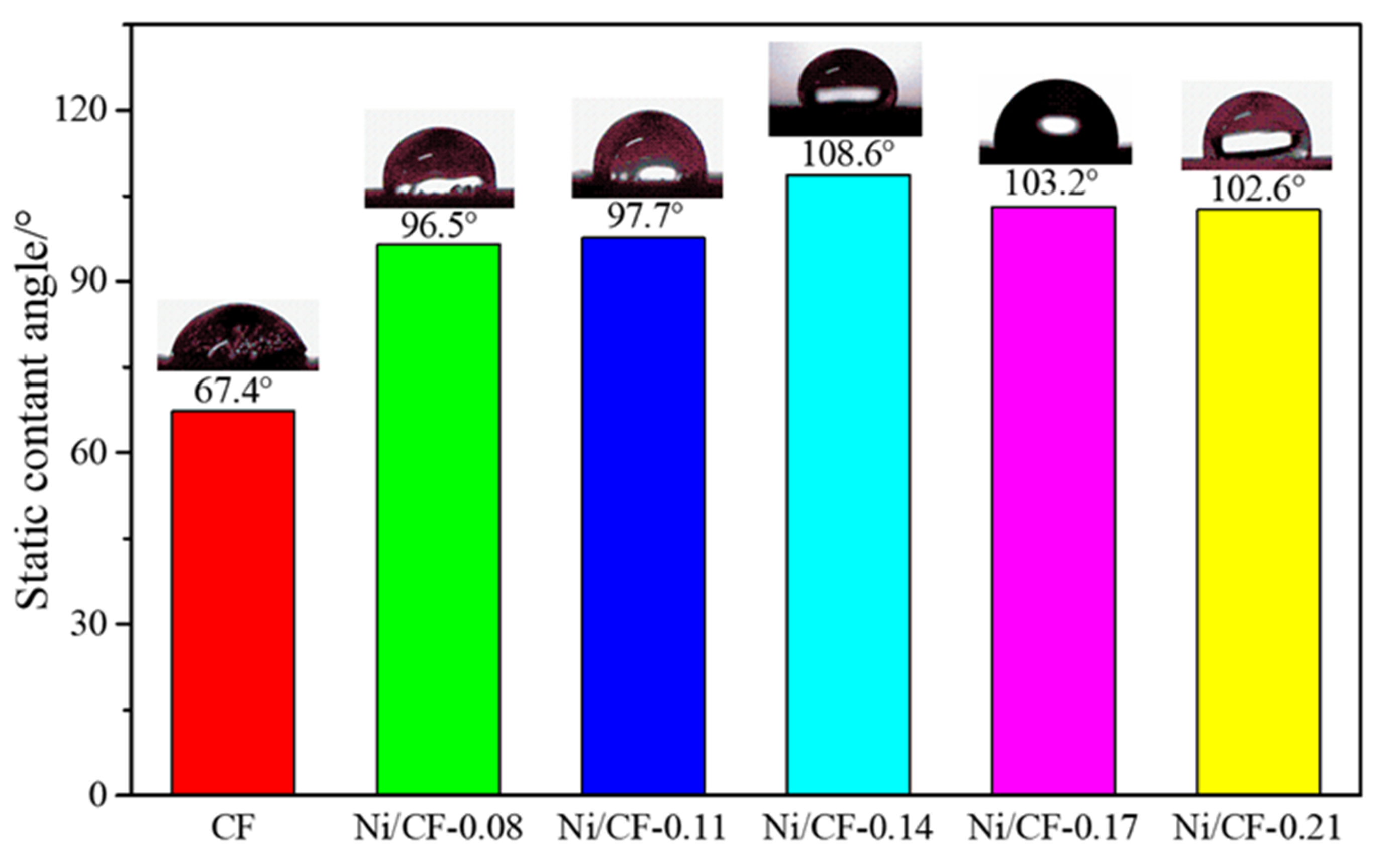

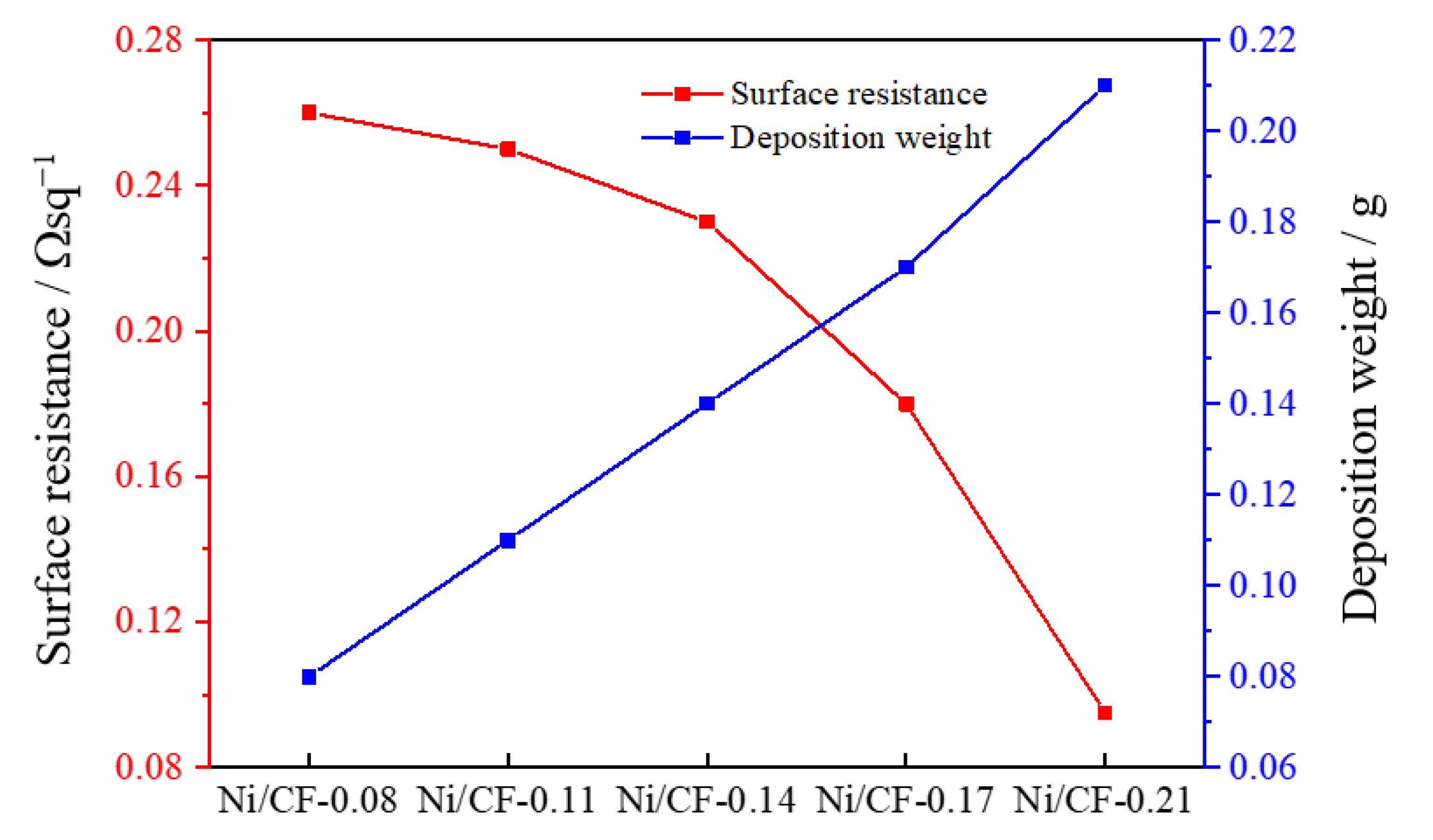
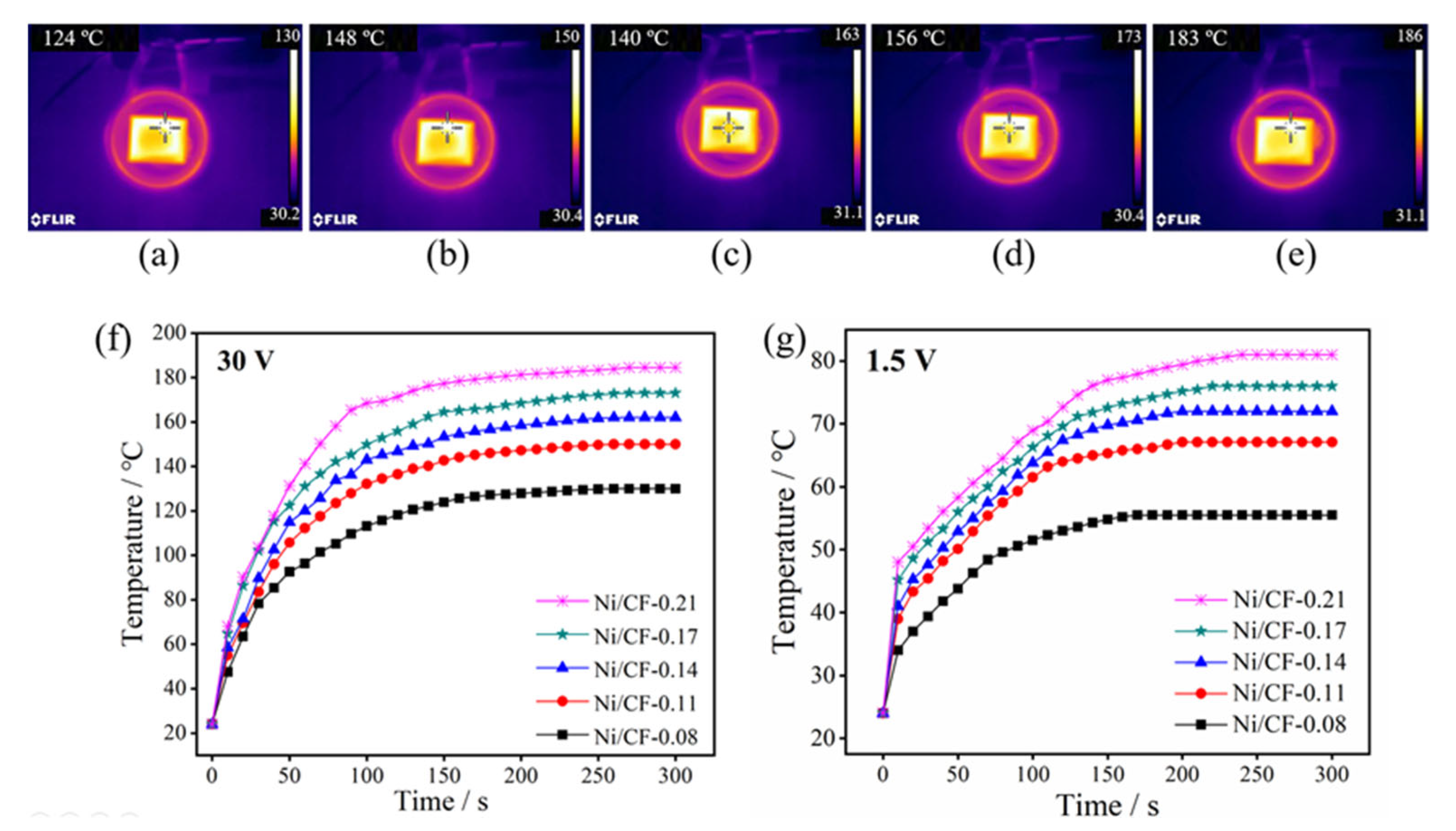
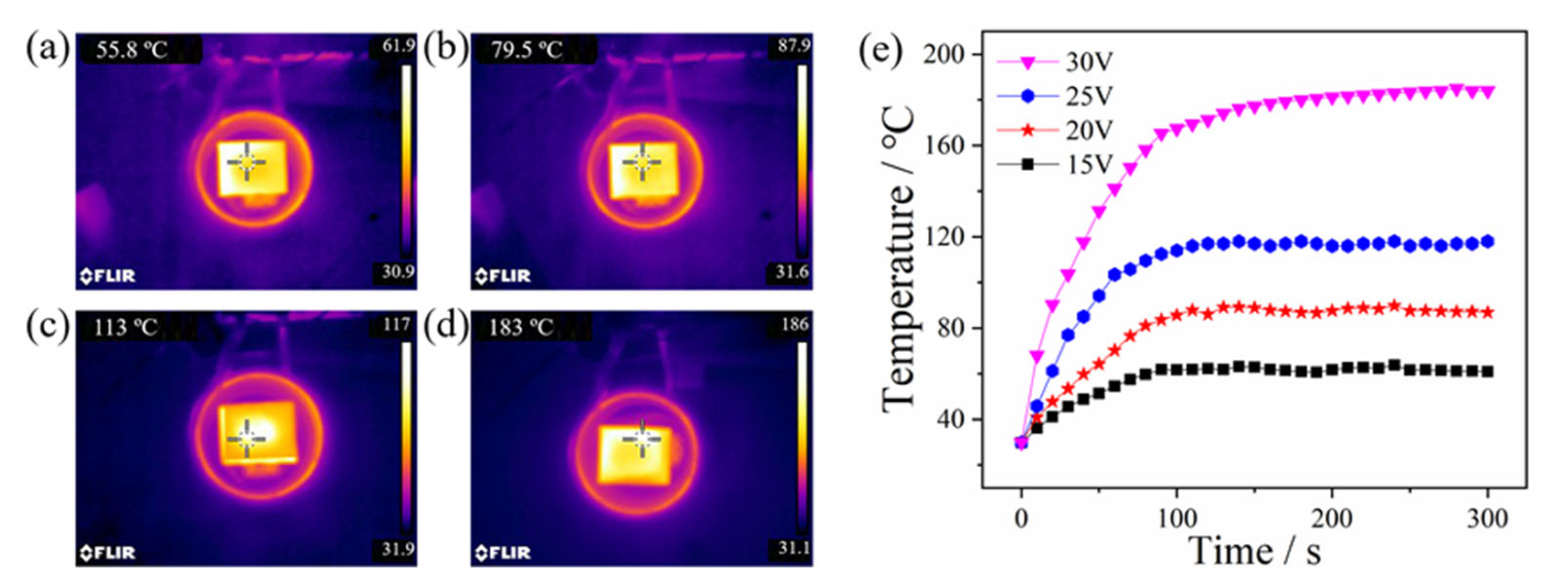
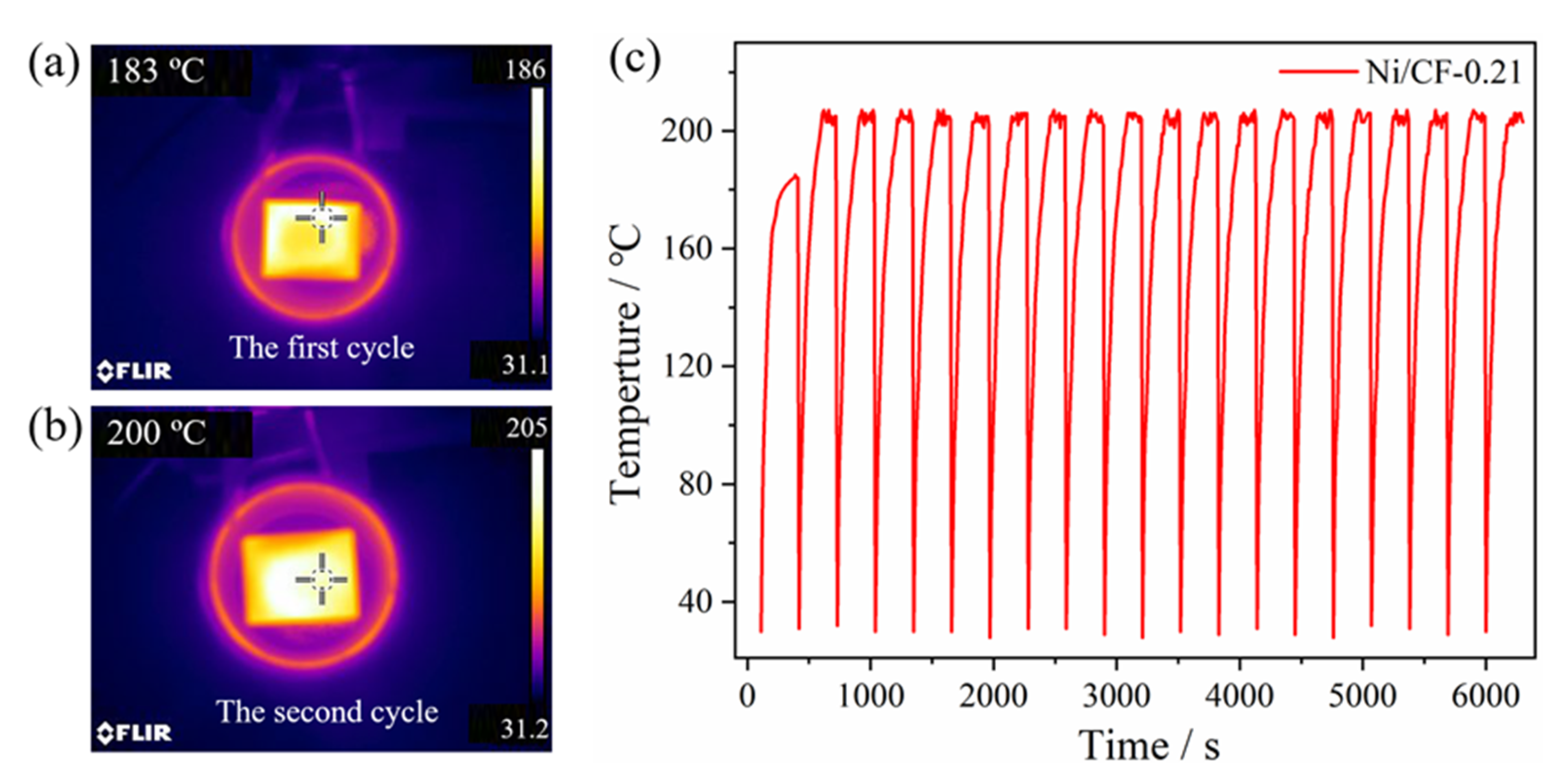

Disclaimer/Publisher’s Note: The statements, opinions and data contained in all publications are solely those of the individual author(s) and contributor(s) and not of MDPI and/or the editor(s). MDPI and/or the editor(s) disclaim responsibility for any injury to people or property resulting from any ideas, methods, instructions or products referred to in the content. |
© 2023 by the authors. Licensee MDPI, Basel, Switzerland. This article is an open access article distributed under the terms and conditions of the Creative Commons Attribution (CC BY) license (https://creativecommons.org/licenses/by/4.0/).
Share and Cite
Pang, J.; Qin, W.; You, W.; Zhong, M.; Meng, Q. Induction Heating Characteristics of Electroless Ni-Coated CFRP for Deicing and Anti-Icing. Coatings 2023, 13, 1531. https://doi.org/10.3390/coatings13091531
Pang J, Qin W, You W, Zhong M, Meng Q. Induction Heating Characteristics of Electroless Ni-Coated CFRP for Deicing and Anti-Icing. Coatings. 2023; 13(9):1531. https://doi.org/10.3390/coatings13091531
Chicago/Turabian StylePang, Jie, Wenfeng Qin, Wentao You, Mian Zhong, and Qing’an Meng. 2023. "Induction Heating Characteristics of Electroless Ni-Coated CFRP for Deicing and Anti-Icing" Coatings 13, no. 9: 1531. https://doi.org/10.3390/coatings13091531
APA StylePang, J., Qin, W., You, W., Zhong, M., & Meng, Q. (2023). Induction Heating Characteristics of Electroless Ni-Coated CFRP for Deicing and Anti-Icing. Coatings, 13(9), 1531. https://doi.org/10.3390/coatings13091531





